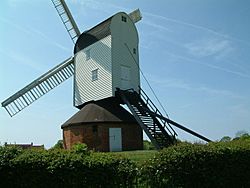Mountnessing Windmill facts for kids
Quick facts for kids Mountnessing Mill |
|
|---|---|

The restored mill, April 2007
|
|
| Origin | |
| Mill name | Mountnessing Mill |
| Mill location | TQ 631 979 |
| Coordinates | 51°39′22″N 0°21′29″E / 51.656°N 0.358°E |
| Operator(s) | Essex County Council |
| Year built | 1807 |
| Information | |
| Purpose | Corn mill |
| Type | Post mill |
| Roundhouse storeys | Single storey roundhouse |
| No. of sails | Four sails |
| Type of sails | Spring sails |
| Windshaft | Cast iron |
| Winding | Tailpole |
| Auxiliary power | Portable steam engine |
| No. of pairs of millstones | Two pairs |
Mountnessing Windmill is a very special old windmill located in Mountnessing, Essex, England. It's a type of windmill called a post mill. This amazing building was first built in 1807. It was fixed up and made able to work again in 1983. It is considered a Grade II* listed building, which means it's a very important historical site.
Contents
The Mill's Story
Mountnessing Windmill was built in 1807. It took the place of an even older mill that had been there for a long time. Records show that a windmill has stood in this spot since 1477! The mill worked for many years, grinding grain, until 1924. It even worked for a short time again in 1932 and 1933.
In 1937, the mill was given to the Mountnessing Parish Council. It was repaired to honor King George VI during the year he became king.
Bringing the Mill Back to Life
The windmill was carefully fixed up between 1979 and 1983. During this time, a brand new roof was put on. The back part of the mill, called the tail, was also rebuilt. New sails were added, making the mill look complete again.
The mill was officially opened on November 13, 1983, by a person named Hervey Benham. Inside, the machinery was also rebuilt by Peter Stenning and Richard Seago. Thanks to their hard work, the mill can now work fully again!
How Mountnessing Windmill Works
Mountnessing Windmill is a post mill. This means the whole top part of the mill, called the 'body', can turn around on a big central post. This helps the sails face the wind. The mill has a roundhouse with sixteen sides at its base.
The mill has four spring sails. These sails are designed to catch the wind and make the mill's machinery move. To make sure the sails always face the wind, the mill is turned using a long pole called a tailpole. Inside the mill, there are two pairs of millstones. These stones grind grain into flour.
Inside the Mill's Structure
The main frame of the mill, called the trestle, is made of strong oak wood. The very large central post is made of elm wood. This post is almost 19 feet (about 5.8 meters) long!
The mill originally didn't have a roundhouse. The roundhouse, which is made of brick, was added later. It has a roof covered in tarred felt. Before 1909, the roundhouse roof was made of thatch. But it had to be replaced because it was full of rats!
Sails and Windshaft
When the mill was first built, it had a wooden shaft that held the sails. It also had simpler sails. Now, the mill has strong cast iron sails. The main shaft that the sails turn, called the windshaft, is also made of cast iron. It was likely used in another mill before it came to Mountnessing.
The Mill's Machinery
Inside the mill, there's a large wooden brake wheel. This wheel has 77 teeth and helps control the speed of the mill. It connects to another wheel called a wallower, which has 21 teeth.
There's also a cast-iron spur wheel, which is about 3 feet 6 inches (about 1.07 meters) wide. This wheel has 66 teeth. It helps turn the two pairs of millstones from underneath. Each stone has 32 teeth. In its later years, a portable steam engine was sometimes used to help the mill grind grain. This engine was built by Wedlake & Dendy Ltd.
Millers of Mountnessing Windmill
Over the years, several people worked as millers at Mountnessing Windmill. A miller is the person who operates the mill and grinds the grain. The Agnis family ran the mill for a long time.
- Robert Agnis (1807 - 1826)
- Joseph Agnis (1826 - )
- Alfred Agnis (1863)
- Joseph Agnis ( - 1906)
- Robert Agnis (1908 - 1924)
- Emily Agnis (1932 - 1933)
Visiting the Mill
Mountnessing Windmill is open for people to visit! You can go see it on the third Sunday of each month. It's usually open from May through October. It's a great chance to see a working historical windmill up close.

